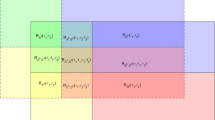Abstract
An explicit design of a linear dispersive space-time-frequency (STF) code is investigated with a design criterion achieving a high rate for frequency-selective channels when the partial interference cancelation (PIC) group decoding is implemented at receiver. With an appropriate grouping scheme, the proposed STF code is shown to obtain a similar diversity gain as that of the maximum likelihood (ML) decoding, namely the full-dimensional sphere decoding, but with a low complexity. It seems as an intermediate decoding approach between the ML decoding and the zero-forcing (ZF) decoding. The present grouping design criterion for the PIC group decoding that provides full diversity with orthogonal-frequency-division multiplexing (OFDM) is also an intermediate condition between the loosest ML full rank criterion of codewords and the strongest ZF linear independence of column vectors of the equivalent frequency-selective channel matrix. Simulation results show that the proposed PIC group decoding scheme can well address the rate-performance-complexity tradeoff of the multiple-input multiple-output orthogonal-frequency-division multiplexing (MIMO-OFDM) wireless communication system.


Similar content being viewed by others
References
Alamouti SM (1998) A simple transmit diversity technique for wireless communication. IEEE J Sel Areas Commun 16(10):1451–1458
Gong Y, Letaief KB (2001) Space-frequency-time coded OFDM for broadband wireless communications. In: IEEE GLOBECOM. San Antonio, Texas, pp 519–523
Guo X, Xia X-G (2009) On full diversity space-time block codes with partial interference cancellation group decoding. IEEE Trans Inf Theory 55:4366–4385
Heath RW, Paulraj AJ (2002) Linear dispersion codes for MIMO systems based on frame theory. IEEE Trans Signal Process 50(10):2429–2441
Jafarkhani H (2001) A quasi-orthogonal space-time block code. IEEE Trans Commun 49(1):1–4
Lu B, Wang X, Narayanan KR (2002) LDPC-based space-time coded OFDM systems over correlated fading channels: performance analysis and receiver design. IEEE Trans Commun 50(1):74–88
Shang Y, Xia X-G (2007) Overlapped Alamouti codes. In: IEEE GLOBECOM. Washington, DC, pp 2927–2931
Shang Y, Xia X-G (2008) Space-time block codes achieving full diversity with linear receivers. IEEE Trans Inf Theory 54(10):4528–4547
Su W, Safar Z, Liu KJR (2005a) Full-rate full-diversity space-frequency codes with optimum coding advantage. IEEE Trans Inf Theory 51(1):229–249
Su W, Safar Z, Liu KJR (2005b) Towards maximum achievable diversity in space, time and frequency: performance analysis and code design. IEEE Trans Wirel Commun 4(4):1847–1857
Zhang J-K, Liu J, Wong KM (2005) Linear Toeplitz space time block codes. In: IEEE int. symp. inf. theory. Adelaide, Australia, pp 1942–1946
Zhang W, Xia X-G, Ching PC (2007) High-rate full-diversity spacetime-frequency codes for broadband MIMO block-fading channels. IEEE Trans Commun 55(1):25–34
Zhang W, Xia X-G, Letaief KB (2007) Space-time/frequency coding for MIMO-OFDM in next generation broadband wireless systems. IEEE Wirel Commun 14(6):32–43
Author information
Authors and Affiliations
Corresponding author
Additional information
This work was supported by the National Natural Science Foundation of China (61071096, 61272495), World Class University R32-2012-000-20014-0 NRF, Korea, and partly by the Science and technology program of Hunan Province in China (2012TZ2017), the Education Science Twelfth Five Plan Project of Hunan Province in China (XJK011BGD050), and the bilateral cooperation of the science foundation between China and Korea (NSFC-NRF 61111140391).
Rights and permissions
About this article
Cite this article
Mao, Y., Peng, J., Guo, Y. et al. On high-rate full-diversity space-time-frequency code with partial interference cancelation group decoding for frequency-selective channels. Multimed Tools Appl 74, 43–61 (2015). https://doi.org/10.1007/s11042-013-1446-4
Published:
Issue Date:
DOI: https://doi.org/10.1007/s11042-013-1446-4




